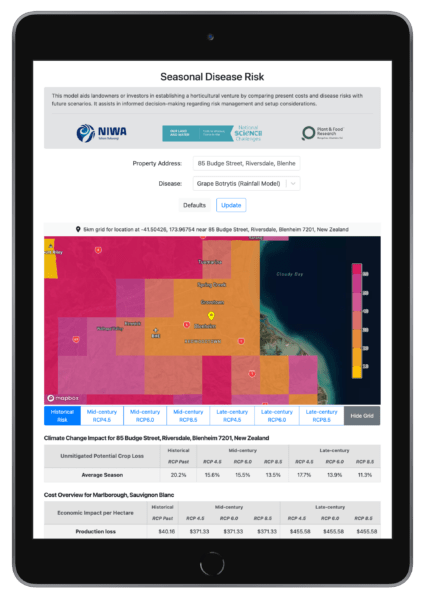New Digital Tool to Help Apple & Grape Growers Adapt to Climate Change
A free interactive tool has been launched to provide apple and grape growers and prospective investors with a glimpse into how climate change may affect the risk and costs of living with common plant diseases in different parts of New Zealand.
A free interactive tool has been launched to provide apple and grape growers and prospective investors with a glimpse into how climate change may affect the risk and costs of living with common plant diseases in different parts of New Zealand.
Created as part of the Our Land and Water National Science Challenge, the Changing Climate: Disease Risk & Costs tool allows people to enter their orchard or vineyard’s address to view the risk of Apple Fire Blight, Grape Powdery Mildew and Grape Botrytis on their crops under different climate change scenarios.
It also translates that risk into financial terms, helping people understand how climate change may affect the cost of managing plant diseases on their land in the decades ahead.
“In simple terms it’s a portal into the future,” says Mike Barley, the director of New Zealand agri-tech company HortPlus.
“It helps with climate adaptation planning and provides easy to digest information for people in the apple and winegrowing industry who want to understand how plant disease risks are likely to change, and importantly, what the cost implications of those changes might be.”

HortPlus developed the tool as part of the Crop Disease Under Climate Change project, in collaboration with Plant & Food Research (disease models), NIWA (climate models), the Agribusiness and Economics Research Unit (economic modelling) and Applied Research & Technologies (disease model reviews).
Agribusiness and Economics Research Unit researcher John Saunders said the tool’s combination of GIS risk mapping and climate, disease and economic modelling made it unique.
“The aim is to let people get a bit of an idea about what the future holds before it arrives. If you are buying a house you would check flood maps. Why shouldn’t we have rich information about the likely impact of plant diseases for horticulturalists?”
Saunders said the economic modelling used took a range of factors into account, including likely increases or decreases in the costs of disease control measures, such as spraying, as well as changes in crop yield that might result in different climatic conditions.
In addition to being a helpful resource for growers and investors, he said the tool would also help central and local government planners to understand how plant disease risk is changing at a regional and national level, and how much it might cost to mitigate those risks in the future.
“The slight silver lining is that some regions may become more viable for certain crops as the climate changes. North Canterbury might become more suitable for growing grapes, for example.”
John Saunders, Agribusiness and Economics Research Unit researcher and part of the team on this project
“New Zealand’s viticulture industry is worth more than $2 billion in exports and our apple industry almost $1 billion, so they are both consequential to the country’s economy.
“Resources like this can help with strategic thinking. In many ways the success of Sauvignon Blanc was just a happy accident in New Zealand. We could help find the next opportunity more quickly with better data and a more planned approach.”
While increases in average temperatures typically resulted in higher costs for management of plant diseases, there were some exceptions, Saunders said.
“The slight silver lining is that some regions may become more viable for certain crops as the climate changes. North Canterbury might become more suitable for growing grapes, for example.”
Even in areas where the costs of managing disease were increasing, profitability would still be possible in many cases, Saunders said.
The Changing Climate: Disease Risk & Costs tool was funded by the New Zealand Ministry for Business, Innovation and Employment as part of the Our Land and Water (Toitū te Whenua, Toiora te Wai) National Science Challenge. Its development was informed by leading researchers, as well as iwi and leaders from across the pipfruit, viticulture, kiwifruit, forestry, nuts, avocado, arable, and education sectors.
More information:
- Changing Climate: Disease Risk & Costs tool
- Crop Disease Under Climate Change project information
Author
 View Our Strategy Document 2019 – 2024
View Our Strategy Document 2019 – 2024




Leave a Reply